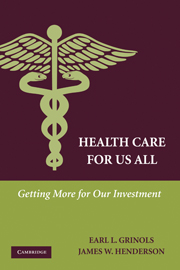Book contents
- Frontmatter
- Contents
- List of Tables
- List of Figures
- Preface
- Acknowledgments
- Executive Summary of the Targeted Intervention Plan
- PART I GOALS AND WORKING PRINCIPLES
- PART II BACKGROUND ECONOMICS AND ETHICS
- PART III APPLICATION
- 6 Why Government in Health Care?
- 7 Insurance
- 8 The Targeted Intervention Plan
- PART IV PROTECTIVE MEASURES
- A Top Ten Goals for the American Health Care System
- B Badly Done Insurance Programs Can be Worse Than No Insurance
- C Incentive Symmetry and Intervention Principle
- D Plan Workability
- E Market Power Response to Insurance
- Glossary and Definitions
- References
- Index
7 - Insurance
Published online by Cambridge University Press: 05 June 2012
- Frontmatter
- Contents
- List of Tables
- List of Figures
- Preface
- Acknowledgments
- Executive Summary of the Targeted Intervention Plan
- PART I GOALS AND WORKING PRINCIPLES
- PART II BACKGROUND ECONOMICS AND ETHICS
- PART III APPLICATION
- 6 Why Government in Health Care?
- 7 Insurance
- 8 The Targeted Intervention Plan
- PART IV PROTECTIVE MEASURES
- A Top Ten Goals for the American Health Care System
- B Badly Done Insurance Programs Can be Worse Than No Insurance
- C Incentive Symmetry and Intervention Principle
- D Plan Workability
- E Market Power Response to Insurance
- Glossary and Definitions
- References
- Index
Summary
Employer financing of medical care has caused the term “insurance” to acquire a rather different meaning in medicine … it has become common to rely on insurance to pay for regular medical examinations and often for prescriptions.
Milton Friedman, Nobel Economist, “How to Cure Health Care,” 2001Summary: Things are not always what they seem: Insurance is not pre-paid care. It is not charity transfers. “Cherry picking” or “cream skimming” is an indication of a healthy insurance market, while “utilization gatekeeping” – denial of claims for covered services rendered – indicates a sick insurance market. Moral hazard and adverse selection are concerns for underwriters, who should not be expected to act against their own interests for the success of public policy with respect to health insurance. On the other hand, legally enforced ethical insurance requires guaranteed renewability of health insurance at standard rates.
Separating pre-paid care, charity transfers, and utilization gatekeeping from the pure function of risk sharing and pooling, allowing freedom to underwrite, and addressing selected intertemporal issues combine to place health insurance on a solid footing. Health insurance in America cannot be said to have failed, when it has not been tried for years.
What's Wrong with This Tale?
The insurance agent related the following story. A client arrived at his office to buy health insurance. In the interview process the client was asked about pre-existing conditions. Yes, the client's wife was eight months pregnant. Yes, he wanted insurance to cover the expenses he expected to have in the next month. And, yes, he was definitely not happy when the agent explained that, of course, this pre-existing condition could not be covered.
- Type
- Chapter
- Information
- Health Care for Us AllGetting More for Our Investment, pp. 109 - 129Publisher: Cambridge University PressPrint publication year: 2009

